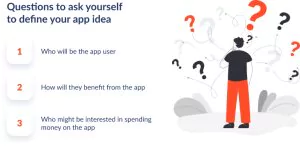A minimum viable product (MVP) development is crucial to the success of a startup, since it helps to test your business idea without spending a lot of resources. Today, only 10% of startups succeed, while the rest fail mainly due to misreading the market demand. By developing MVP, you can understand whether users really need a solution you’re going to offer or not.
Even though you might already know what MVP is and how to define it, developing one is yet another important step to make. What should go next? What to start with?
JatApp has 7 years of experience in software development for startups all over the world, so we have enough expertise to share with you. In this article, we’ll discuss how to build an MVP, why you need to consider the Agile approach, and what secret weapon we use to develop an MVP for our clients.
What is the Agile approach and what it has to do with MVP?
The Agile is a model of software development life cycle (SDLC) that approaches product development as a series of iterations. The project can take as many iterations as necessary to develop a final product, which is why it’s always possible to go back and correct any errors.
Each period of iteration necessarily involves such processes as:
- Planning
- Requirements analysis
- Designing
- Building
- Testing
You might already have noticed that the use of the Agile approach for MVP design and development is explained with the iterative nature of the model. Having an opportunity to frequently change the design, add/remove features, and try different ways of marketing is crucial for understanding what kind of product will be popular with the users.
In fact, iterations are critical not only for MVP development, but also proof of concept (POC) and prototyping that usually precede a minimum viable product. These three terms are often confused with each other, which is why we recommend reading our article about the difference between POC, prototype, and MVP.
Three crucial aspects of your MVP
Any MVP has to achieve three things: identify the core value of the product, validate the business idea, and gather feedback from users. So, let’s discuss each thing in more detail.
Core value identification
The primary role of any MVP is to determine a distinct value it creates for consumers. People have tons of problems to deal with each day, so identifying one and offering a simple solution to it is the first thing an MVP should do.
For instance, Uber’s MVP started as an app allowing users to book a taxi from a smartphone and pay for a ride with a credit card. In this case, people had a problem catching a taxi cab and using cash to pay. Uber solved this problem by offering an app that helps to book a ride in a couple of taps.
Uber’s MVP
The core value Uber delivered has shown its viability, so the startup engaged in development of new features for their product and soon became the global leader in the industry of taxi services.
Validation of business idea
Checking whether your business idea actually works and can make profits is another important thing your MVP is expected to clarify. You just have assumptions and guesses about how your product can relieve a user’s pain. Launching your minimum viable product lets you see whether you can continue scaling your startup.
For example, Airbnb founders assumed that travelers would like to stay at local hosts’ apartments rather than book a hotel.
Airbnb’s MVP
The assumption was successfully tested, so the startup scaled up to the globally used marketplace.
How Airbnb looks today
Gathering feedback
MVP development is pointless if it doesn’t gather any feedback from the target audience. Having feedback from your early customers will give you insights on whether your product creates value and what features should be added or improved.
The case of JatApp can serve as a relevant example. We worked on a blockchain-based content management platform for the Dubai government. JatApp presented the Dubai Government’s delegation an MVP with all the required components: mobile app, web-based application, and backend service with the blockchain integration.
The MVP got positive feedback, and JatApp continued working on the solution. The product was fully launched in 2019, but our cooperation with the client continues.
The solution’s user interface
Build your MVP correctly
There are three steps to build an MVP: talk to users, launch quickly, and get feedback. Sure, you need more details, so let’s jump right into discussion.
Talk to users
As we’ve already mentioned, people have many problems to solve each day. When you have identified the pain point and found the way to fix it, it’s still important to talk to someone who deals with this specific problem regularly. Talking to your target audience can provide you with a more accurate vision of how your product is going to manage the users’ pains.
JatApp’s case of working on the Near Miss Reporting App is an on-point example here. Our client had a problem with frequent near misses at the workplace, so they wanted to develop a solution that promotes a safety culture inside the organization.
You won’t argue that reporting about slightly noticeable things is not what the majority of employees would enjoy, so some effective way to motivate employees was much needed.
After engaging with the customer and gathering specifications for the project, JatApp decided to include gamification and social networking features to make near miss reporting more fun and pleasant to do. The client accepted our approach, so JatApp successfully built the mobile app and web-based dashboard.
Near Miss Reporting App user interface
Launch quickly
The logic behind this recommendation is simple. The earlier you launch your MVP, the faster you’ll get the first feedback. That’s why we highly recommend you to associate your launch with getting early customers rather than having an article about your startup published by TechCrunch.
Launching your MVP quickly sounds way too simple, but it can be tough in practice, so here are some tips to help you:
- Schedule your features development. Even though you can never know where an iterative process will lead you, it’s better to plan what features you’re going to develop with each iteration. The entire plan may change right after the first iteration, but you’ll have a starting point at least.
- Write down the specifications. It’s important to have all your technical specifications recorded, so you can decide what should be developed first. Writing down all tech specifications helped JatApp to design the architecture for an automated powerbank rental platform. With the architecture in mind, we were able to focus on the basic features.
Renting a powerbank by scanning a QR code on the charging station
- Cut out unimportant features. Observe all the features you’re going to include and leave only those that are the most valuable. If you’ve already selected only important features, still cut out some to save precious time. You need to roll out just enough features to represent the core value of the product.
Get feedback
As soon as you launch your MVP, it’s time to gather feedback from your customers. Find how you can talk to them remotely or create a survey that will show whether your MVP is in demand.
You may think that testing a product that barely works is a waste of time. In fact, it’s not true, because a quick launch and feedback can help you understand whether you need to keep following the same approach to development of your product.
Early feedback can give you an idea of what consumers really expect. It may turn out that the idea in your head is not what your customers actually need.
For that reason, get rid of a weak MVP with no hesitation. In case you got negative feedback about your product, it’s reasonable to think that something is wrong with the software rather than users. So, we don’t recommend mourning for your failed MVP too long. It’s much more productive to start iterating the new version as soon as possible.
On a side note, it’s important to remember that getting no feedback at all is also a red flag. The reasons can vary, but you still have to review your MVP and its marketing strategy. The product itself can be totally fine, but improper marketing is a pitfall many startups fall into.
How JatApp develops MVP
And now, it’s time to talk about the “secret weapon” we use for the MVP development process. Actually, JatApp always relies on a profound product discovery and development of basic features without bugs.
Product discovery is a project’s stage, during which we actively communicate with a customer and determine what business needs should be addressed. Then, our business analysts deeply research the market to find opportunities for building a product’s competitive advantage.
Owing to a thorough product discovery done by our business analysts, JatApp managed to meet the business needs of Brandon Learning Centre and develop PreQuest, a web-based test preparation platform for students aged from 9 to 12 years old.
PreQuest user interface
As for the focus on the core features, JatApp team believes that development of basic features without bugs and errors helps a client to keep scaling their product.
For example, when we worked on a cross-platform VPN solution, we committed all efforts to the development of the basic features for the MVP. When the MVP proved its value, we offered our customer to engage in the development of a more complex functionality. The product became a reliable foundation of the client’s business and gathered more than one million users.
How cross-platform VPN solution works
What’s more, JatApp always pays much attention to Quality Assurance and testing of any solution we develop. It’s possible to effectively validate MVP only when the target audience has no problems with using the product’s basic features.
Take your MVP seriously and remember that there’s a long way to go
Building a minimum viable product is just the end of the beginning, excuse us for such a figure of speech. The final product can be dramatically different from your MVP, but it doesn’t mean you shouldn’t take your MVP seriously. Anyway, MVP development is paramount for any startup, as it helps to understand whether the right direction is taken.
On top of that, you still need to have a good tech team who can build your MVP without much trouble. JatApp can provide you with access to the largest talent pool in the Eastern Europe. We can assemble a tech team according to your requirements, so our engineers will serve the best interest of your startup.
Get in touch with us, and we’ll get back to you soon.














